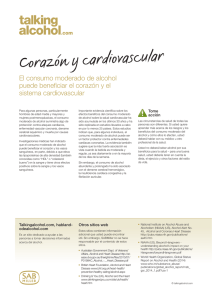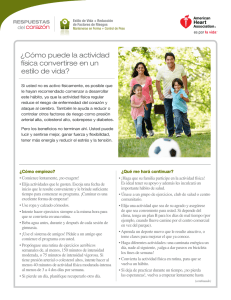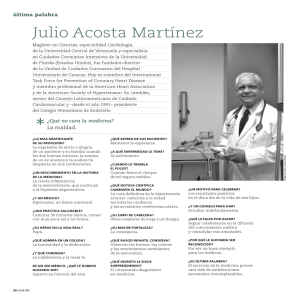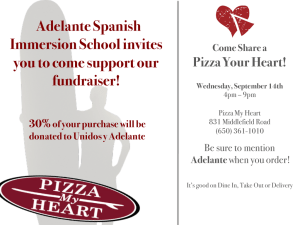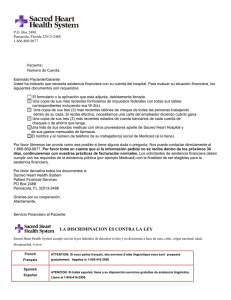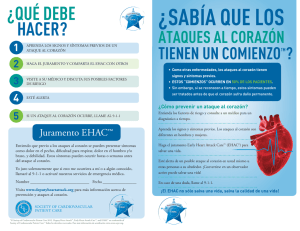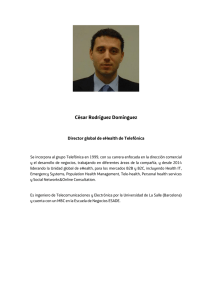Warning Signs of a Heart Attack
Anuncio
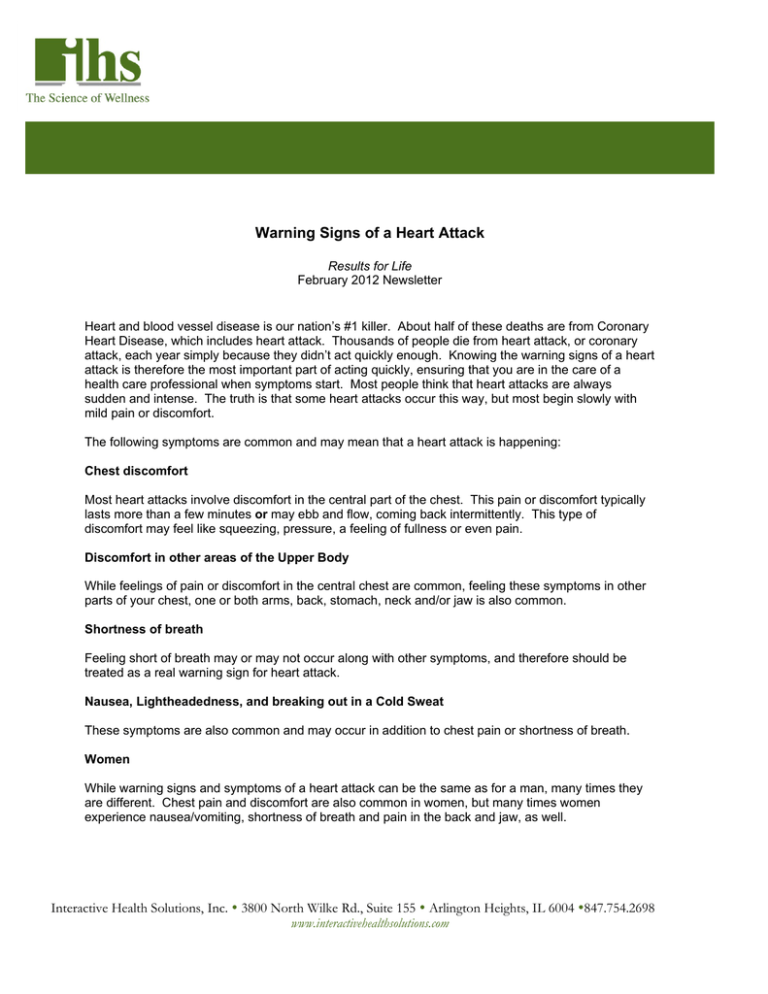
Warning Signs of a Heart Attack Results for Life February 2012 Newsletter Heart and blood vessel disease is our nation’s #1 killer. About half of these deaths are from Coronary Heart Disease, which includes heart attack. Thousands of people die from heart attack, or coronary attack, each year simply because they didn’t act quickly enough. Knowing the warning signs of a heart attack is therefore the most important part of acting quickly, ensuring that you are in the care of a health care professional when symptoms start. Most people think that heart attacks are always sudden and intense. The truth is that some heart attacks occur this way, but most begin slowly with mild pain or discomfort. The following symptoms are common and may mean that a heart attack is happening: Chest discomfort Most heart attacks involve discomfort in the central part of the chest. This pain or discomfort typically lasts more than a few minutes or may ebb and flow, coming back intermittently. This type of discomfort may feel like squeezing, pressure, a feeling of fullness or even pain. Discomfort in other areas of the Upper Body While feelings of pain or discomfort in the central chest are common, feeling these symptoms in other parts of your chest, one or both arms, back, stomach, neck and/or jaw is also common. Shortness of breath Feeling short of breath may or may not occur along with other symptoms, and therefore should be treated as a real warning sign for heart attack. Nausea, Lightheadedness, and breaking out in a Cold Sweat These symptoms are also common and may occur in addition to chest pain or shortness of breath. Women While warning signs and symptoms of a heart attack can be the same as for a man, many times they are different. Chest pain and discomfort are also common in women, but many times women experience nausea/vomiting, shortness of breath and pain in the back and jaw, as well. Interactive Health Solutions, Inc. y 3800 North Wilke Rd., Suite 155 y Arlington Heights, IL 6004 y847.754.2698 www.interactivehealthsolutions.com ACT QUICKLY! Half of all people having a heart attack wait on average, two hours before seeking help. The recommendation is however, to call 9-1-1 or emergency medical services (EMS) within 5 minutes of symptoms. Many people are worried about having a “false alarm” or talk themselves out of seeking medical attention, which can mean the difference between life and death. How do I prevent a Heart Attack? • • • • • • • • Don’t smoke and avoid second-hand smoke Treat high blood pressure if you have it Eat foods low in cholesterol, saturated fat, trans fat, and salt Be physically active Maintain a healthy weight Get regular medical check ups Take medication as prescribed Control your blood sugar if you have diabetes For more information: - Speak to your physician or health care provider Resources American Heart Association – www.heart.org American Stroke Association – www.strokeassociation.org Interactive Health Solutions, Inc. - www.interactivehs.com Interactive Health Solutions, Inc. y 3800 North Wilke Rd., Suite 155 y Arlington Heights, IL 6004 y847.754.2698 www.interactivehealthsolutions.com Fit Tip of the Month Exercise After a Heart Attack More than 1 million Americans suffer a heart attack, or myocardial infarction (MI), each year. If you fall into this category, you should know that a regular exercise program and a healthy diet after MI can save your life. Research suggests that exercise reduces death from both cardiovascular causes, and in general. Further, the atherosclerotic process is slowed, and the risk of having another cardiovascular event is decreased. Your PMD may recommend a cardiac rehabilitation center as a one stop shop for you to receive a safe, medically supervised program with monitored exercise, and trained guidance counselors in the areas of nutrition, stress and weight management. Recipe of the Month Did you know that choosing colorful fruits and vegetables can help promote good health? During the February make it your goal to serve colorful heart healthy dinners. Try this menu and recipes to help add color to your meals: Pizza Soup Serves 6 1 T olive oil 1 C onions, sliced 1 C green bell pepper, cut into 1-inch pieces 1 C red bell pepper, cut into 1-inch pieces 1 T minced garlic 2 C water 2 cans (14.5 oz.) Italian diced tomatoes, undrained 1 can (6 oz.) tomato paste 1 C mushrooms, sliced Interactive Health Solutions, Inc. y 3800 North Wilke Rd., Suite 155 y Arlington Heights, IL 6004 y847.754.2698 www.interactivehealthsolutions.com 1 1/2 t Italian seasoning 1 can (15-16oz.) kidney beans, rinsed and drained 1 can (15-16oz.) great northern beans, rinsed and drained 6 slices French bread, each 1/2 in. thick 1 1/2 C shredded reduced fat mozzarella cheese 1. Heat oil in pan over medium heat. Cook onion, bell peppers and garlic in oil, stirring occasionally, until onion is tender. 2. Stir in water, tomatoes, and tomato paste until blended. Stir in remaining ingredients except bread and cheese. Heat to boiling; reduce heat. Cover and simmer 10 minutes, stirring occasionally. 3. Just before serving, heat oven to 425. Place bread on ungreased cookie sheet. Toast bread in oven about 6 min., turning over once until golden brown. 4. Sprinkle soup with low fat cheese if desired and serve with toasted French bread on the side. Webinar Information: The March live member webinar is scheduled for Thursday March 22, 2012 at 12:00 CST, “Supermarket Smarts-Navigating the Aisles for Good Health”. Look for registration information in the March Issue of Results for Life Health Newsletter. To view last month’s recorded webinar – “Small Steps to a Healthier Weight” Go to – www.interactivehs.com Interactive Health Solutions, Inc. y 3800 North Wilke Rd., Suite 155 y Arlington Heights, IL 6004 y847.754.2698 www.interactivehealthsolutions.com Señales de un ataque de corazón Resultados por vida Febrero 2012 Boletín La enfermedad del corazón y el vaso sanguíneo es el #1 asesino de la nación. Acerca de la mitad de estas muertes son de la Enfermedad Cardiaca, que incluye infarto. Miles de personas se mueren del infarto, o de ataque coronario cada año simplemente porque ellos no actuaron rápidamente. Conociendo las señales de alerta de un infarto son por lo tanto la parte más importante de actuar rápidamente, asegurando que está en el cuidado de un profesional de salud cuando síntomas comienzan. La mayoría de las personas piensan que infartos son siempre repentinos e intensos. La verdad es que algunos infartos ocurren en esa manera, pero empiezan más lentamente con dolor o agitación templados. Los síntomas siguientes son comunes y pueden significar que un infarto esta sucediendo: Dolor en el pecho La mayoría de los infartos incluye dolor en la parte central del pecho. Este dolor o agitación duran típicamente más de unos minutos o pueden bajar y pueden fluir, regresando intermitentemente. Este tipo de dolor se describe como apretándole, una presión, un sentirse inflado o aún dolor. Dolor en otras áreas del Cuerpo Superior Mientras el dolor o agitación en el pecho central son comunes, sintiéndose estos síntomas en otras partes del pecho, de uno o de ambos brazos, la espalda, el estómago, el cuello y/o la mandíbula son también comunes. La falta de poder respirar Sentirse que no puedes respirar no siempre ocurre junto con otros síntomas, y por lo tanto debe ser un señal de alerta verdadera para el infarto. La náusea, el mareo, y el tener un calor frio Estos síntomas son también comunes y pueden ocurrir además de dolor de pecho o falta de poder respirar. Las mujeres Mientras señales de alerta y síntomas de un infarto pueden ser iguales para un hombre, muchas veces también son diferentes. El dolor de pecho y la agitación son también comunes en mujeres, pero muchas veces mujeres notan náusea/vomitar, la falta de poder respirar y el dolor en la espalda y la mandíbula, también. Interactive Health Solutions, Inc. y 3800 North Wilke Rd., Suite 155 y Arlington Heights, IL 6004 y847.754.2698 www.interactivehealthsolutions.com ¡ACTUE RAPIDAMENTE! La mitad de todas las personas que tienen un infarto esperan un promedio de dos horas antes de buscar ayuda. La recomendación es sin embargo, para llamar 9-1-1 o los servicios médicos de emergencia (SME) dentro de 5 minutos de sentir los síntomas. Muchas personas están preocupadas por tener una "falsa alarma" o se convencen a sí mismo de no buscar atención médica, pero puede significar la diferencia entre la vida y la muerte. ¿Cómo puedo prevenir un Infarto? • • • • • • • • No fumar y evitar respirar el humo de los cigarrillos Vigilar la hipertensión si usted lo tiene Comer alimentos bajo en colesterol, la grasa saturada, grasa de “trans”, y en la sal Ser físicamente activo Mantener un peso sano Visitar el doctor regularmente para los exámenes físicos Usar la medicina como esta prescrito Controla su nivel de azúcar en la sangre si tiene la diabetes Para más información: Habla con su proveedor de médico Recursos La Asociación norteamericana del Corazón – www.heart.org La Asociación norteamericana del derrame – www.strokeassociation.org Interactive Health Solutions. - www.interactivehs.com Interactive Health Solutions, Inc. y 3800 North Wilke Rd., Suite 155 y Arlington Heights, IL 6004 y847.754.2698 www.interactivehealthsolutions.com Las Recetas del Mes La Salud del corazón en color ¿Sabes que comer frutas y verduras de diferentes colores pueden ayudar a promover la salud buena? Durante el mes de Febrero ponga una meta de servir cenas coloradas y saludables para el corazón. Intente este menú y las recetas para ayudarle agregar color a sus comidas: Solomillo de Cerdo asado con Salsa de Cerezas Secas de Michigan Batatas estilo Glaseada con Manzanas Rojo Las frutas y las verduras rojas pueden vivificar su dieta con beneficios que promueven la salud para ayudar la salud del corazón, las funciones de la memoria y bajar el riesgo de cáncer. Lomo de Cerdo Asado con Hierbas y Salsa de Cerezas Secada Sirve 6 1½ libra. Solomillo de cerdo 1 cucharada de aceite de oliva ½ cucharadita de sal ½ cucharadita pimienta negra ½ cucharadita secó tomillo La salsa: 1 taza (8 onzas) de caldo del pollo ¾ taza (6onzas) jugo de manzana ¼ taza (2 onzas) salsa de soja bajo en sodio 1 cucharada de maicena ½ taza (4 onzas) se cebolla cortada (opcional) ½ taza (4 onzas) de cerezas seca 1. Coloque el lomo de cerdo en la bandeja para hornear. Usando un cepillo añadir aceite de oliva sobre el lomo. Rocíe con sal, la pimienta, y el tomillo. Asar en un horno de 350º F durante 40-50 minutos o hasta que la temperatura interna del lomo alcance 155-160º F. 2. Mientras el lomo de cerdo hornea, agregue el pollo de caldo, jugo de manzana, la soja y maicena en una cacerola. Mezclado para remover cualquier reserva de maicena. Agregue las cebollas cortadas a la mezcla. 3. Pon la cacerola sobre el fuego mediano hasta que la salsa empiece a hervir; mezclando la salsa constantemente. Agregue la cerezas seca y baje el fuego a un hierve lento hasta alcanzar la consistencia deseada. 4. Servir con cucharón la salsa sobre el lomo cortado. Interactive Health Solutions, Inc. y 3800 North Wilke Rd., Suite 155 y Arlington Heights, IL 6004 y 847.754.2698 www.interactivehealthsolutions.com Amarillo/Anaranjada Frutas y verduras amarillas y anaranjadas contienen antioxidantes poderosos que ayudan a mantener la salud del corazón, la visión, un sistema inmunológico sano, y baja el riesgo de algunos cánceres. Esto es una manera fácil y sabrosa de preparar la verdura mezclada junta con la fruta. Batatas Glaseadas y Manzanas Sirve 6 4 batatas medianas, peladas y cortadas 4 manzanas de Granny Smith, pelada, sin el corazón de la manzana, y cortada ½ taza de arándanos secó 2 cucharadas de miel 3 cucharadas de jugo de manzana 1 cucharada de margarina en contenedor, sin la grasa “trans”, derretida 1. Arregle las batatas cortadas, las manzanas, y los arándanos en una fuente de hornear de 2 qts. que este rociado con aceite en aerosol 2. Mezcle junta la miel, jugo de manzana, y mantequilla derretida. Disperse la mezcla sobre la batata. 3. Cubrir y hornear las batatas en 350º F durante 30-45 minutos, hasta que las batatas estén tiernas y glaseadas. La Sugerencia Saludable del Mes El Ejercicio Después De un Infarto Más de 1 millones de norteamericanos sufren un infarto, o infarto de miocardio, cada año. Si usted cae en esta categoría, debe saber que un programa regular de ejercicio y una dieta sana después de un ataque de corazón pueden guardar su vida. Los estudios sugieren que el hacer ejercicio reduce la muerte de ambas causas cardiovasculares, y en general. Aún más, el proceso de aterosclerótico es ralentizado, y el riesgo de tener otro problema cardiovascular es disminuido. Su doctor puede recomendar un centro de rehabilitación cardiaco para recibir un programa supervisado con profesionales de salud que incluye ejercicio vigilado, y con consejeros entrenados profesionalmente en las áreas de nutrición, estrés y peso. Interactive Health Solutions, Inc. y 3800 North Wilke Rd., Suite 155 y Arlington Heights, IL 6004 y 847.754.2698 www.interactivehealthsolutions.com La Información de Webinar: (solo en ingles) En Marzo en vivo el webinar para los miembros esta planificado para el jueves 22 de marzo de 2012 a las 12:00 CST, " Navegando el Supermercado los Pasillos para la Salud Buena". Busque información de matrícula en el Boletín de la Salud de la Vida este Marzo. Para mirar el último webinar de el mes pasado (solo en ingles) – "Pequeños Pasos a un Peso más Sano" Va a – www.interactivehs.com Interactive Health Solutions, Inc. y 3800 North Wilke Rd., Suite 155 y Arlington Heights, IL 6004 y 847.754.2698 www.interactivehealthsolutions.com
